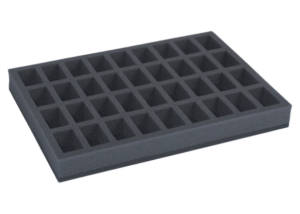Oh so nice, invoking some form of reaction. Siocast is basically both, and it doesn’t matter how you look at it. Strange name for something that should be a blog about defending the process? Well… yes and no and as you are used from me as a valued reader that you are… you know there is something behind this. Let’s start at the beginning of the process and where things could go wrong and right.

Trust the Siocast process?
Absolutely not! From my investigations, it’s the same as with Resin printing. Every machine has it’s preferred settings, but what Siocast itself does not want to hear, also the mixture of thermoplastic. This means that every Siocast producer works with another recipe of what they think is the perfect “brew”.
Experience in Siocast moulding and casting
There is a great deal to talk about. I found out that there is a great skill factor in the success of a product when using the Siocast machines. The manufacturer showed me that during different steps of the process that there is a lot that can define the end product. It was clear that although the whole casting part of the process only takes about 25 seconds, this does not mean you need to think that these 25 seconds deliver perfect casts. That is where a lot of the companies that use the machines go wrong. This part is also where you hear the most complaints about.
Rule of the Siocast thumb
If you don’t take time to learn the process, you get bad models. Your prototype product needs to be in perfect pristine condition before you start moulding the models. The first big step in this process is clean components and most of all… skill… We did mention this before, haven’t we?
Siocast moulding
Basically, the mould making is a bit the same as making a cake, but with plastic components. First off, you need a couple of good models to start off with. These are most of the time 3D prints. You also need the mould mould (yes, you read that correctly).

Time for the sprue. This is the connection to the model prototypes that you want to produce. The models are pressed up against the sprue, so that they connect. Besides the newly made sprue in the clay, there are specific pins pressed in the clay where the two halves of the mould find their middle point. Another slab of clay is pressed on top of the bottom part with all the models in it. You let it cool off, and you remove the metal mother sprue and models. A mould is born.
Siocast Casting
This is the part where the skill comes in and defines a bad model from a near perfect model. The mould we just made in the column above, is now being fed into the Siocast machine. Thermoplastic is liquified and injected into the mould. 25 seconds and a huge amount of pressure later, this is taken out of the machine, opened up, and you have a sprue of awesome stuff… At least, if there is patience and skill involved. So, what could go wrong here:

Among more things that I could name, some of the most common ones are temperature. Waiting to have everything to temperature takes more time than casting. The companies that massively churn out models like there is no tomorrow, do not wait until the mould is heated, and start when the plastic is liquid. Big mistake, because the plastic will cool down too fast, making the model look less “crisp” of even just missing details.
Of course with a work day, you might only have these “miscasts” in the beginning of the day. The untrained eye or regular mini painter won’t even see the difference. It’s to such a degree that you can’t even call them miscasts. Problem is, that every machine is different and finding out the sweet spot in temperature might take some time. It could even be different from day to day, depending on the weather conditions and time of year.
Most people complaining that Siocast is not up to par with the wargaming standards have models from that early start of the day or just plain wrong configurations of machinery. Have we mentioned skill already?
Quality vs. Purpose
Another not really popular thing, is that the recipe one uses to make the plastic pellets mixes is dependent on the quality as well. Mixing specific types together creates a stronger or more brittle end product. Next to that, the purpose of the end product is also dependent on the recipe. Single role playing miniatures need to withstand a beating. Wargaming miniatures benefit from a less flexible, harder recipe.
If there is less skill in cooking up a good recipe, you use the basic one that they offer or advise. Just like with 3D printing, mixing the now famous RPG resin (flexible) with a more sturdy one like Siraya tech model resin, makes for a way better product than just the RPG resin. I am not saying individually the products are bad, but a mix is just better! Same with Siocast plastic. Skill and trial and error here too.
Eco-friendly
So, I could start with just the moulder and injector? Completely correct! But there is also the scrapper, and that could be any brand that could break down the plastic into tiny particles that could function as pellets. This is also the reason you don’t see a lot of sprues going round in sold boxes.

Why would you? The process of making models with Siocast, is cheaper because you can take off the sprues and recycle them. Same with miscasts, which go into the same grinder and dive in the injector to become something better as pellet sized chunks.
Is Siocast better or worse than Injection moulded plastic?
Although the machines have been on the market for some time now (4+ years commercially?), we only start to see the bigger companies like Corvus Belli using the technology. As mentioned before, there is also a pretty steep learning curve and fully understanding the passion of one such machine, is like marrying your wife that you just met before stepping into Townhall to get married.
This is the sole reason people are still on the fence of thermoplastic miniatures. When a producer of a model or brand is not fully comfortable and within understanding of the machinery, you create something that is not up to par with what you expect from a company that otherwise creates amazing detailed models.

Conclusion
I personally think that if the process is fully understood, it will be picked up by more companies. It could some day even completely erase the need for the dreaded and flash heavy PVC miniatures. Does this mean Siocast is better or worse than the HIPS plastic counterpart? No, it’s a wholly different ballgame and I truly hope this stays that way. There is however a lot to gain with Siocast.
Think about smaller companies that want to create some models. From design to the first physical miniatures, the cost is below 1000 euros and with one mould (last time I checked) one can mould about 1000 sprues. A decent frame can carry about 10 monopose minis, meaning you can make 10000 minis from a 1000 euro! This is of course, assuming there is only one design and the casting itself is free (which is mostly not, but talking about abilities here).
In other words. If the skill and curiosity to experiment with recipes is there, there is a whole world of gamers lying at the feet of the relatively new technology. The pioneers that employ it now, will become the giants at the forefront of the technology. We should applaud them for that, but not accept laziness of just going with what comes out of the machine!
Want to try Siocast models?
Of Course you do now! Check out the first of the many products to come from Corvus Belli’s Warcrow Range, which employs the technology for the complete range. If you already have some Siocast models or some form of experience with them, let us know too!

